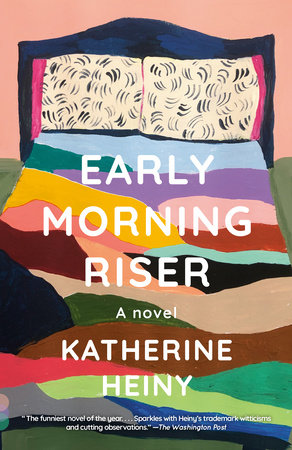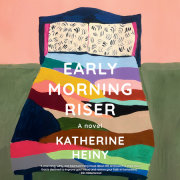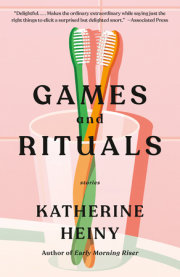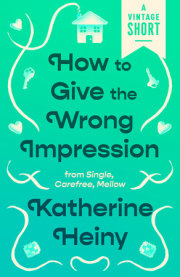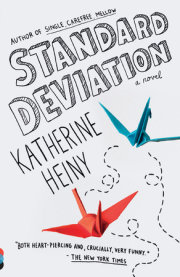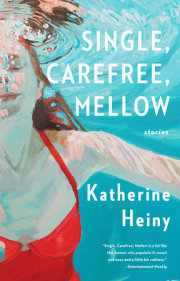Jane met Duncan a month after she moved to Boyne City. She had locked herself out of her house and had had to ask a neighbor to call a locksmith. She was sitting on her front steps in the early twilight wearing her pajamas—she taught second grade and it was Pajama Day—when Duncan drove up in a rust-spotted white van.
“Whoa,” he said when he saw her. “Exactly how long have you been waiting?”
He was in his early forties, with slightly shaggy auburn hair and a full moustache. His eyes were brown with amber flecks, and his features were so symmetrical that his face looked as though it could have been cut from a piece of paper folded in half. He was of medium height, medium build, wearing nothing more distinctive than jeans and a denim shirt, yet he seemed to stand out vividly, like the subject of a photo with a blurred background. To Jane he looked like the Brawny paper towel man, and no less handsome.
“Only about twenty minutes,” she said. She stood up and gestured at her front door. “I’m afraid you may have to drill the lock out.”
“Oh, I doubt that,” Duncan said. “I bet we can find another way in. Folks always think their houses are totally safe because they have a couple locks on the front door, and then they call me and it turns out they’ve been sleeping with a bedroom window open for half a year. Let’s take a walk around.”
They circled the house slowly. It was a pretty little one-story house, white with black shutters. Duncan kept stopping to look in the flower beds. “It’s also possible the previous owners left a key in a false rock or some such.”
At the back of the house, Duncan pointed to the bathroom window. “Here’s what I’m talking about. I could pop the screen off there and climb right in if the window’s not locked.”
“Okay,” Jane said meekly.
He slid the end of a screwdriver under the edge of the screen, and it popped loose with alarming ease. Duncan caught it with one hand. “Not much crime around here,” he said to Jane, “but last year Shirlene Talbot woke up to find a man making himself a ham sandwich in her kitchen. He was pretty harmless—turned out he was the Masseys’ houseguest and was too drunk to remember which house they lived in. Still, I’d hate for that to happen to you.”
He dragged Jane’s garbage can over, climbed on top of it, and pushed the window open. He ducked inside, and a minute later, he opened the front door and called out to her.
Jane thanked him and asked him to stay for supper. She had never spontaneously invited a man to stay for supper before but she was grateful he hadn’t charged her anything. Also, she hadn’t had a real conversation with a man since she’d moved here, unless you counted the elderly man at Glen’s Market who had asked her to help him find his car.
She was twenty-six years old, tall and slender, with dark blond hair that looked good in a ponytail, and she didn’t need much makeup. That last part was fortunate because she rarely wore any. Her eyebrows and eyelashes were naturally dark despite the light color of her hair, and her pale blue eyes were almond-shaped, with slightly hooded lids that made eyeshadow pointless and hard to apply. (This had baffled Jane in her teen years when she followed step-by-step eyeshadow tutorials in magazines—wait, where was the crease of her eyelid? Why did she look exactly the same afterward?) She had a straight nose and a generous mouth. She was very pretty when she remembered to sit up straight, and pretty enough when she slouched.
During supper—Jane made an omelet and a salad—Duncan told her that he was really a woodworker and specialized in custom-made tables and chairs, but since someone wanted one of those only every once in a while, he also did antique furniture restoration and locksmithing, and that he’d grown up in a small town in the Upper Peninsula, and that he used to be married to a real estate agent named Aggie who could not tell the difference between a smallmouth and largemouth bass. (Jane wasn’t sure if that was just some descriptive detail about Aggie or Duncan’s reason for divorcing her.)
“Where is Aggie now?” she asked.
“Where?” Duncan said. “This time of night, she’s probably home over on Alice Street, I guess.”
“Oh,” Jane said. “I didn’t realize she lived around here.”
“Yeah, nice little house. I mow her lawn still.”
Jane folded her napkin into smaller rectangles. “You must be very close.”
“I don’t know about close.” Duncan took a bite of his omelet. “We’re friendly enough, I guess, seeing as she up and left me for Gary Polnichik at State Farm, and they’ve been together almost ten years now.”
“Why doesn’t Gary mow the lawn?” Jane asked.
“He doesn’t like it, and I don’t mind,” Duncan said. “Plus, he helps me with my taxes.”
Duncan talked a lot. He told Jane that she should buy eggs from the farmers’ market, and that she should never order the clam chowder at Robert’s Restaurant, and that the dentist had a drinking problem but morning appointments were generally okay, and that Bradley Reed up on the corner had a tendency to watch folks with his binoculars if they left their window shades up, and that the olive burger at the Boyne River Inn couldn’t be beat, and later he said, “I’m the luckiest man in Boyne City,” as he pulled Jane’s pajama pants off while she lay back on her sofa.
“But Boyne City is only about two hundred people!” Jane protested.
Duncan looked thoughtful. “Actually, more like three thousand.”
“Still, you’re supposed to say in the universe,” she said.
“How about Northern Michigan?” Duncan ran his hands up the insides of her thighs. “Will that do? I’m the luckiest man in Northern Michigan.”
That was on a Friday, and neither Jane nor Duncan left the house until Monday morning, when Jane had to go to school.
This was only Jane’s third year of teaching. You could say she was still getting the kinks out.
During her first two years of teaching—one in Grand Rapids, one in Battle Creek—she had made the first day of school as fun-filled and exciting as possible: extensive school tour, scavenger hunt, time capsule, extra recess, dance party, LEGOs, working with clay. The result had been that both Jane and her students were hollow-eyed and slack-jawed with fatigue by three thirty, and no one remembered where the bathroom was the next day anyway.
She had finally realized that although second graders were officially entering the third year of schooling (more if they’d gone to preschool), they had clearly wiped all previous school experience from their hard drives over the summer. They had to relearn everything, like stroke patients: how to find their desks, how to form a line, how to walk quietly in the hall, how to keep their hands to themselves, how to grip a pencil, how to hold scissors carefully, how to take off and put on their coats, how to flush the toilet—how to aim for the toilet, in some cases—and to wash their hands afterward.
They had to relearn the rhythm of the school day, too. Some children were still on a summer rock-star schedule and would become suddenly alert about ten in the morning and look around in a slightly startled fashion, as though their minds had just caught up with their bodies. Others for whom naps were a very recent memory (for instance, the day before school started) would grow wobbly-headed and slow-blinking right after lunch and remain that way for at least an hour. Always on the first day, at least three students would turn their heads to the clock at 3:25 and slowly count down the remaining seconds. (Probably more would have done it, but hardly any of them remembered how to tell time.)
This year, Jane had kept the first day of school extremely simple. The only writing materials were chubby three-sided pencils and soft dashed-line writing paper with one-inch lines. The bulletin boards were bare, and she’d turned most of the displays toward the wall or covered them with plain brown paper. (Her classroom looked like the background in a proof-of-life hostage photograph.) She put only plain wooden blocks in the toy chest, no cars or trucks, not the farm animals or the pretend grocery items. The art table was covered in butcher paper and only primary-color crayons were available for drawing. The Library Corner held only board books, nothing longer or more challenging or less familiar than The Very Hungry Caterpillar.
They had begun the day by making nametags (a boy named Tad Berman had raised his hand and asked Jane how to spell his own first name) and storing their gym shoes under their desks. They counted to one hundred by tens, and discussed “greater than” and “less than.” They reviewed the days of the week and the months of the year. (“Just twelve of them?” Tad Berman asked. “Are you sure?”) They read sight words that Jane printed one at a time on the whiteboard, and then Jane read The Gruffalo aloud. After lunch they made “All About Me” posters and sat in a circle to play Jingle Bell Pass, and by the end of the day, her students had emerged from the first day with some semblance of sanity and awareness.
The second day, she uncovered the bulletin boards and added wooden cylinders and triangles to the toy box. (A girl named Alicia Sweet had stared at one of the triangles, frowning, for at least thirty seconds before asking Jane what that shape was called.) Jane unrolled the Peter Rabbit rug in the Library Corner and put the Dr. Seuss books on the shelves. They measured lengths of string and practiced adding ten to any number. They discussed word families and phonetics.
On the third day, Jane turned all the displays so they faced the room and added glue and glitter and ribbon to the Art Table. She hung the “All About Me” posters around on the walls and left work folders on everyone’s desk. Tad Berman was able to identify her by name (two out of three times anyway), and Paul Blankenship, who was the first week’s Attendance Messenger, was gone for only twenty minutes or so when he took the attendance sheet to the school office three doors down (the day before, it had taken him almost an hour). Jane passed out math workbooks and had the students open to the first page. The school year had begun.
And now, only three weeks later, Jane was suffering from such massive sleep deprivation after her weekend with Duncan that she had to show a video during Science while she sat at her desk, trying not to doze off in the darkened room. She showed videos during Health and Social Studies, too. At the end of the day, Kenny Rutledge said that was more screen time than he was allowed in a whole month and that he would need a note to take home to his mother.
Jane did have one friend in Boyne City, Freida Fitzgerald.
Jane and Freida had met at the teachers’ ice cream social at the very beginning of the year (the fact that she went showed how desperate Jane was to meet people). The social was held in the high school media center, which meant everyone had to worry about tripping over electrical cords. Or everyone would have had to worry if anyone had come besides Jane and the other second-grade teacher, Mr. Robicheaux, and the school custodian, who said he was just waiting for everyone to go home so he could lock up.
Copyright © 2021 by Katherine Heiny. All rights reserved. No part of this excerpt may be reproduced or reprinted without permission in writing from the publisher.

